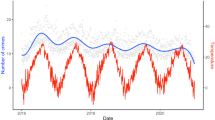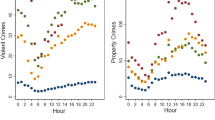Abstract
The cold floor pattern (a lack of homicides on days with extremely cold temperatures that was found by Cheatwood in Baltimore) is to be expected by chance. Under a model in which the number of homicides and the maximum temperature are independent, the probability that a day will fall below the cold floor is small. The Baltimore data do not support a model in which extremely cold weather suppresses human aggression.
Similar content being viewed by others
References
Chambers, J., Cleveland, W. S., Kleiner, B., and Tukey, P. A. (1983).Graphical Methods for Data Analysis, Wadsworth International Group, Belmont, CA.
Cheatwood, D. (1995). The effects of weather on homicide.J. Quant. Criminol. 11: 51–70.
National Climatic Data Center (1994). Summary of the day: First order (Minneapolis International Airport). National Oceanic and Atmospheric Administration. Asheville, NC.
Stata Corporation (1995)Reference Manual STATA Release 4, Vol. 1, State Corp., College Station, TX.
Author information
Authors and Affiliations
Rights and permissions
About this article
Cite this article
Loftin, C., Cheatwood, D. Cold floor effects on homicide. J Quant Criminol 12, 439–444 (1994). https://doi.org/10.1007/BF02354427
Issue Date:
DOI: https://doi.org/10.1007/BF02354427




